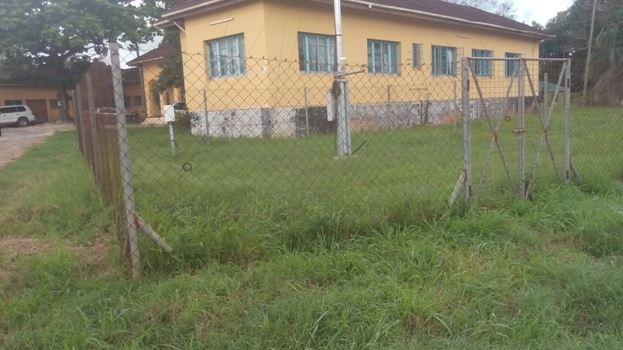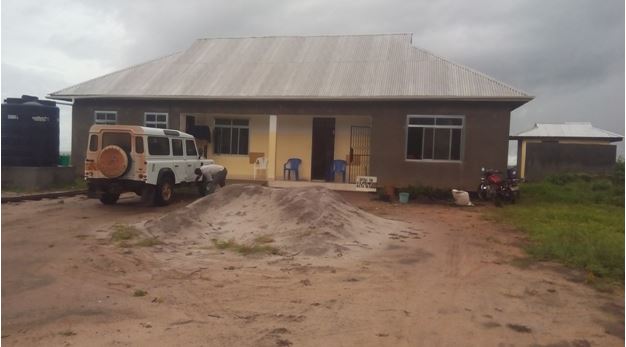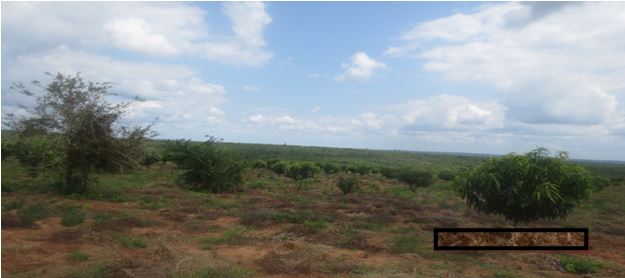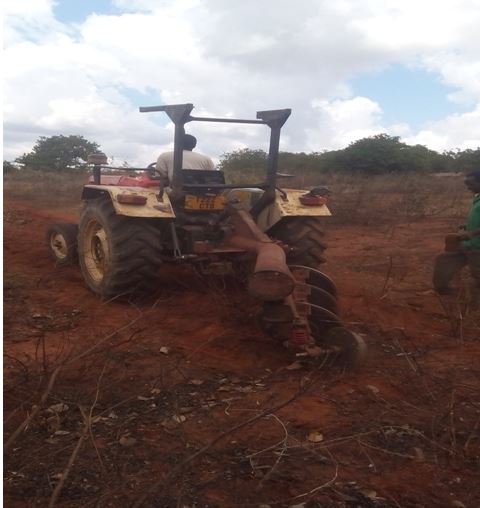The area is 353 500 ha, (3,535 Km2) where arable land is 380 000 ha of which 30 000 ha is under cultivation (NBS, 2002).
Kisarawe District is characterised by two main rain seasons: short rain season (vuli) which starts from October and ends in December and the long rain season (masika), starting from March and ends in early June. The average annual rainfall ranges from 1 400mm to 1600 mm in the eastern part of the district which covers Sungwi Division, while the western part which covers Chole and Mzenga Divisions receives an average annual rainfall of 1000 mm (KDC, 2010).

Fig. 1 Kisarawe weather station
Temperature is the degree of hotness or coldness of a body. The area has an undulating landscape with an altitude ranging from 150 m to 900 m above sea level. Therefore the area experiences temperature ranging between 280C to 330C with the mean temperature of 30.50C.
According to the National Census of 2012 the district had a total population of 101 598 people with an average growth rate of two point one per cent per annum (2.1%). The population is estimated to be 108 472 people in 2018. Females were 50 967, Males were 50 631 and households number were 26 051. The average number size of the household was three point nine (3.9) people (KDC, 2017).

Fig 2. Map showing Kisarawe District
Agriculture;
Kisarawe District has an extremely large and high potential land for agricultural production but this potential land has not yet been utilized fully, because only 7.9% of its arable land has been utilized (URT, 2007). In the District about 95% of the populations depend on agriculture, most of them being smallholder farmers involved in the production of both cash and food crops. The current major cash crop grown in the district is cashew nut while Cassava is grown as the main food crop, other crops grown are maize, paddy, Sorghum, banana, sweet potatoes, Coconuts and vegetables. Other crops of which there is high opportunity for expansion are tropical fruits such as mangoes, oranges, jackfruits, passions, pineapple and Citrus, (KDC, 2017). The common markets for Kisarawe agricultural produces are Dar es salaam and Kibaha.
CASSAVA VALUE CHAIN
Cassava is a key security crop in Kisarawe District, where it is the first important source of energy and holds great potential as a cash crop through the sale of fresh roots and planting materials.
In recent years the productivity of cassava is very low and continued to decrease. It is currently estimated at 4 tones per hectare in 2014/15 down from 6 – 7 tones per hectare in 2010.
Factors contribute to the low yield including damage by diseases particularly Cassava Brown Streak Disease (CBSD) that is threatening cassava production and productivity in the district.
The disease (CBSD) affects value addition and labour for women who have to remove necrotic tissues from affected roots.
Kisarawe selected to be among the four Districts as a pilot area for cassava phytosanitation project in 2013. Other districts were Chato, Muleba and Mkuranga. The project offers the ideal knowledge on how to reduce the incidence of cassava diseases.
Based on this new knowledge, the project sensitized, mobilized and trained the community to manage and control CBSD and CMD through a ‘Community Phytosanitation’ approach. The strategy involved establishing crops with clean virus free seed, maintaining the health of the cassava crop during the active growth period and avoiding to plant healthy cuttings near diseased crops.
The project carried out intensive awareness activities to help farmers understanding the causes, symptoms and enabling them to actively participate in managing and controlling the disease to improve cassava production and productivity.

Fig.3: Agriculture officer offer house to house training on CBSD and CMD at Mhaga village

Fig 4: Demonstration plot planted KBH 026 at Kitondwe A(Mhaga village)

Fig.5: Demonstration plot planted KBH 026 (right side) and Kiroba (left) at Kitondwe B (Mhaga village)
Also the project trained farmers on cassava processing as a way of increasing shelf life and value of cassava eventually increase the household income.

Fig. 6: Farmers get training on cassava processing at Mhaga village

Fig. 7: Muungano group members show cassava products at Mhaga village in farmers’ field day

Fig. 8: Cassava crop under small scale production at Kisarawe

Fig 9: Agriculture officers when visited a farmer at Kihare Village

Fig. 10:Tomato production plot at Kisarawe Nanenane exhibition ground in Morogoro.

Fig. 11: Ward resource center building at Kibuta.

Fig. 12: Magomba group at Cashew nut Nursery workshop at Kibuta.
CROPS PRODUCTION STATISTICS;
| Type of crop
|
2007/08
|
2008/09
|
2009/10
|
2010/11
|
2011/12
|
2012/13
|
2013/14
|
| Cassava
|
66,857 |
63,036.4 |
240.9 |
10,045 |
25,772.4 |
8,340 |
36,450 |
| Maize
|
814.5 |
7,506 |
1,208.2 |
1,444.6 |
1,278.2 |
4,306 |
3,454 |
| Sorghum
|
2,290 |
1,610 |
35.8 |
48 |
900 |
610 |
261 |
| Paddy
|
8,500 |
722 |
891.3 |
110 |
365 |
1,069 |
590.4 |
| Pulses
|
4,603 |
3,493.5 |
197.8 |
568.6 |
975.8 |
1,120 |
178.1 |
| S.potatoes
|
6,000 |
34,200 |
3,170.7 |
355.5 |
3,650 |
1,326 |
1,380 |
| Total
|
89,064.5 |
110,567.9 |
5,744.7 |
12,571.7 |
32,941.4 |
16,771 |
42,313.5 |
Table 1: Crop production statistics ( tones) 2007 – 2014.

Fig 7.Mango trees farm at Kurui
FRUITS PRODUCTION STATISTICS FROM 2007 – 2014
| Type of fruit
|
2007/08
|
2008/09
|
2009/10
|
2010/11
|
2011/12
|
2012/13
|
2013/14
|
| Orange
|
657 |
692 |
1,140 |
1,148 |
1,158 |
1,158 |
1,158 |
| Mangoes
|
1,163 |
1,165 |
1,166 |
1,173 |
1,173 |
1,182 |
1,190 |
| Coconut
|
7,680 |
7,810 |
7,992 |
7,998 |
8,753 |
8,753 |
8,760 |
| Oil palm
|
1,251 |
1,370 |
1,370 |
1,370 |
1,370 |
1,370 |
1,370 |
| Cashew nut
|
10,000 |
10,000 |
10,100 |
10,100 |
10,100 |
10,100 |
10,170 |
| Total
|
20,751 |
21,037 |
21,768 |
21,789 |
22,554 |
22,563 |
22,648 |
Table 2 : Fruits production statistics,
The District has large area potential for agricultural irrigation which covers about 5,000 ha of which only 40ha are under irrigation at Mianzi village in Msanga ward.
The District has planned to utilize the area potential for irrigation by tapping water from river the project which is worth 3,600,000,000 Tanzania shillings. Implementation of this project is expected to commence subject to availability of funds.
List of Schemes for GPS Survey:- Kisarawe District Council.
|
s/n |
Scheme |
Start of farmland
|
Intake site |
||
|
Latitude |
longtude |
Latitude |
longtude |
||
|
1. |
Mafizi
|
E.038.56096o
|
S.06.99986o
|
E.038.55953o
|
S.07.000660
|
|
2. |
Marui – Mipera (Mtuna bwawani)
|
E.038.767260
|
S.07. 354870
|
E.038.767350
|
S.07.354110
|
|
3. |
Marui – Mipera (Mkongoroni)
|
E.038.765170
|
S.07.343820
|
E.038.7653380
|
S.07.343910
|
|
4. |
Marui – Ngwata (kisoti bwawani)
|
E.038785180
|
S.07.380670
|
E.038.785770
|
S.07.380690
|
|
5. |
Mianzi
|
E.038.781730
|
S.07.305290
|
E.038.781530
|
S.07.304500
|
|
6. |
Nyani
|
E.038.538400
|
S.07.051730
|
E.038.531890
|
S.07.049270
|
Other six Schemes not surveyed are Gwata, Ving’andi, Bwama Doloto, Kimalamisale and Mihugwe

Fig 8. Kitanga Women Cassava production group at the workshop

Fig. 9 Mshikamano Tractor ( a group from Kisanga Village ).
Copyright ©2017 Kisarawe District Council . All rights reserved.